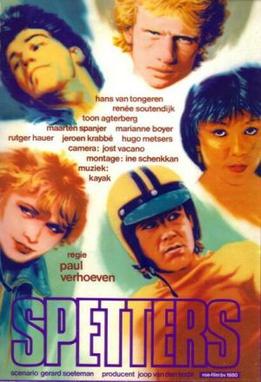
Spetters is a Dutch film released in 1980 and directed by Paul Verhoeven. The film follows the lives of three young men who have little in common but their love for dirt-bike racing. Set on the outskirts of Rotterdam, the film depicts three characters who are hoping to escape a dead-end, working-class existence.

The County of Loon was a county in the Holy Roman Empire, which corresponded approximately with the modern Belgian province of Limburg. It was named after the original seat of its count, Loon, which is today called Borgloon. During the middle ages the counts moved their court to a more central position in Kuringen, which today forms part of Hasselt, capital of the province.

Emanuel de Witte (1617–1692) was a Dutch perspective painter. In contrast to Pieter Jansz Saenredam, who emphasized architectural accuracy, De Witte was more concerned with the atmosphere of his interiors. Though few in number, de Witte also produced genre paintings.

Soldier of Orange, released in the United Kingdom as Survival Run, is a 1977 Dutch romantic war thriller film directed and co-written by Paul Verhoeven and produced by Rob Houwer, based on Erik Hazelhoff Roelfzema's autobiographical book of the same name. Starring Rutger Hauer and Jeroen Krabbé, the film is set around the German occupation of the Netherlands during World War II, and shows how individual students have different roles in the war.
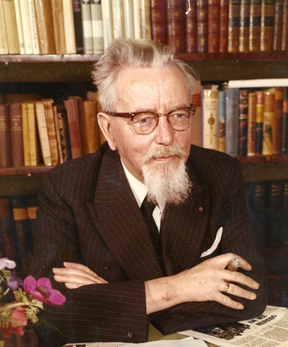
Andreas Ernestus Josephus Claes was a Belgian author. He is best known for his regional novels, including De Witte ("Whitey"), which was the source material for the first Flemish sound film: De Witte (1920). In 1980 it was remade as De Witte van Sichem by Robbe De Hert.
Zichem is a village of the town of Scherpenheuvel-Zichem in the Belgian province of Flemish Brabant. Zichem was an independent municipality until the municipal redistribution of 1977.

Averbode Abbey is a Premonstratensian abbey situated in Averbode, in the municipality Scherpenheuvel-Zichem, in the Archdiocese of Mechelen-Brussels in Belgium. It was founded about 1134, suppressed in 1797, and reestablished in 1834. Throughout the 20th century the abbey press was a leading children's publisher in Belgium. The church's building is a peculiar synthesis of Baroque and Gothic, with Renaissance ornament details, dominating the monastery complex. The whole structure was built of iron sandstone from Langdorp and white sandstone from Gobertange between 1664 and 1672, after a design by the Antwerp architect Jan Van den Eynde II.

Arthur Valentijn Japin is a Dutch novelist. He has won almost every prestigious prize in Dutch literature, including the Libris Prize for his 2005 novel Een Schitterend Gebrek.

Ferdinand Van der Auwera, pseudonym Fernand Auwera was a Belgian writer. His fragile health during his youth and its impact on his life (solitude), had an effect on his first literary work.

The Crosspatch is a 1935 Dutch film directed by Henry Koster and Ernst Winar. It is based upon the German three-act play "Willis Frau" by Max Reimann and Otto Schwartz.

Allotment Wives is a 1945 American film noir directed by William Nigh and starring Kay Francis. Its plot is about an army investigator who tries to shut down a scam that preys on soldiers, and unknowingly falls in love with the woman behind it.

Gaston Petrus Bernardina Berghmans was a Belgian actor and comedian. Between 1972 and 1993 he and Leo Martin formed a comic duo called Gaston and Leo.

Mattheus Verheyden was a painter from the Dutch Republic.
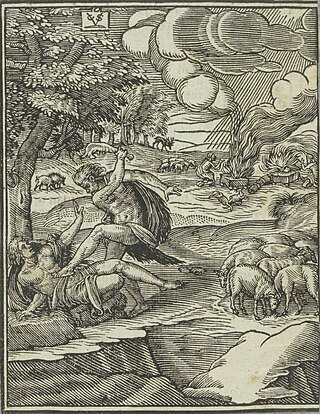
Christoffel van Sichem or Christoffel van Sichem the Younger(1581, Basel – 1658, Amsterdam), was a Dutch woodcutter, engraver and publisher. He was mainly active as a reproductive artist making prints after the prints or paintings of other artists.
Luc Rombouts is a Belgian carillonneur and author. He is the city carillonneur of Tienen in Flemish Brabant. He is also the official carillonneur of both Leuven University carillons and the Park Abbey. He has given numerous concerts in Europe and the US and appeared in festivals and conventions. Together with Twan Bearda he performs in a carillon duet called The Bells' Angels, exploring, expanding and performing four hand carillon repertoire.

De Witte is a Belgian film of 1934 in black and white, directed by Jan Vanderheyden. It is an adaptation of the homonymous book by Ernest Claes.
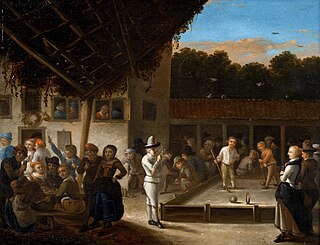
Gerrit Lundens, was a Dutch painter known for his genre scenes, portraits and a single vanitas painting. He also made copies after prominent masters, including Rembrandt. He further operated an inn and was active as a wine merchant.
De Witte is a Dutch and Flemish surname.
Wij, Heren van Zichem was a Flemish TV drama series, originally broadcast between 1969 and 1972 in 26 episodes on the BRT. The program was based on several novels by Ernest Claes, who died just a few months before the show first aired. All episodes were shot in the Flemish village Zichem. At the time it was one of the most popular TV series in Flanders, attracting almost 2,960,000 viewers which is about 3/4 of all Flemish people. Tourism to the village boomed, while it hardly had enough bars, let alone restaurants to accommodate the tourists. In a 2004 interview with Het Nieuwsblad actor Fons Exelmans remembered that tourists were often confused because certain houses and buildings were located less close to each other than in the series. The actors were also invited to appear during annual festivities as promotional stunts.
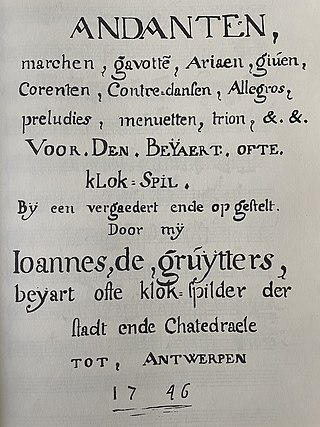
The De Gruytters carillon book is a manuscript notebook that the Dutch Baroque musician Joannes de Gruytters used for performance on the carillon of the city of Antwerp. It contains 194 pieces of music, mostly arrangements and a few original compositions, in the form of marches, gavottes, arias, gigues, preludes, and minuets, among others.
















